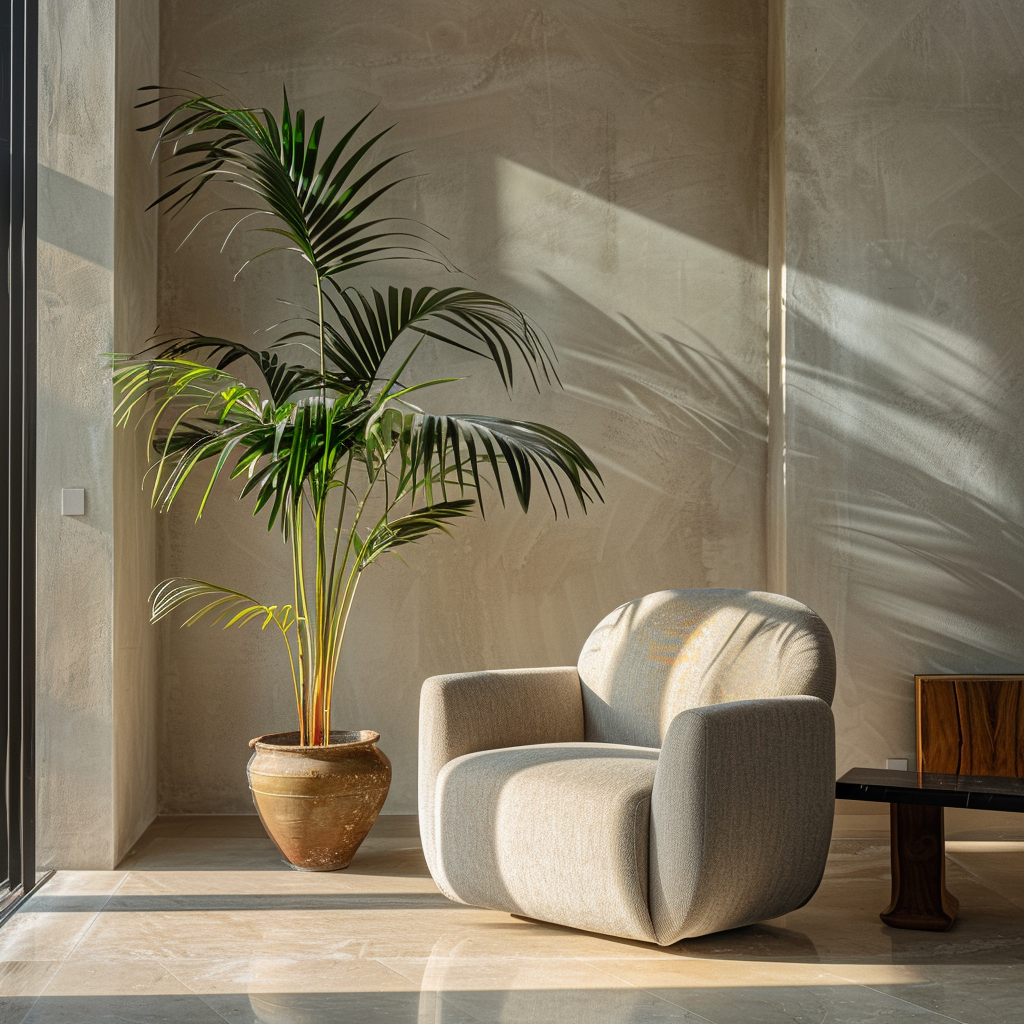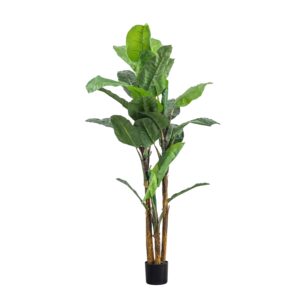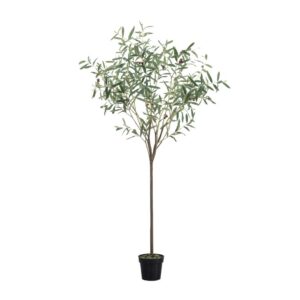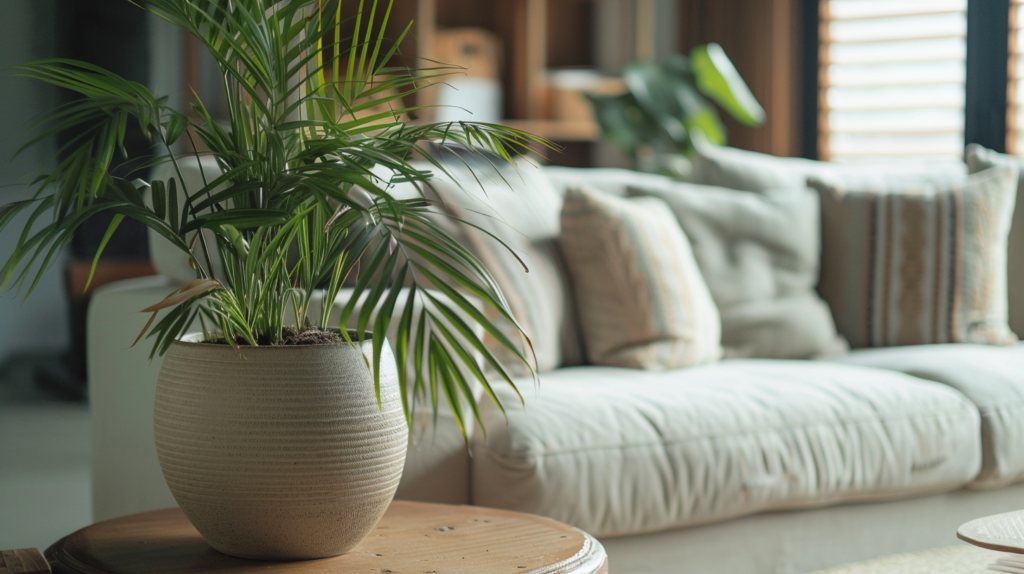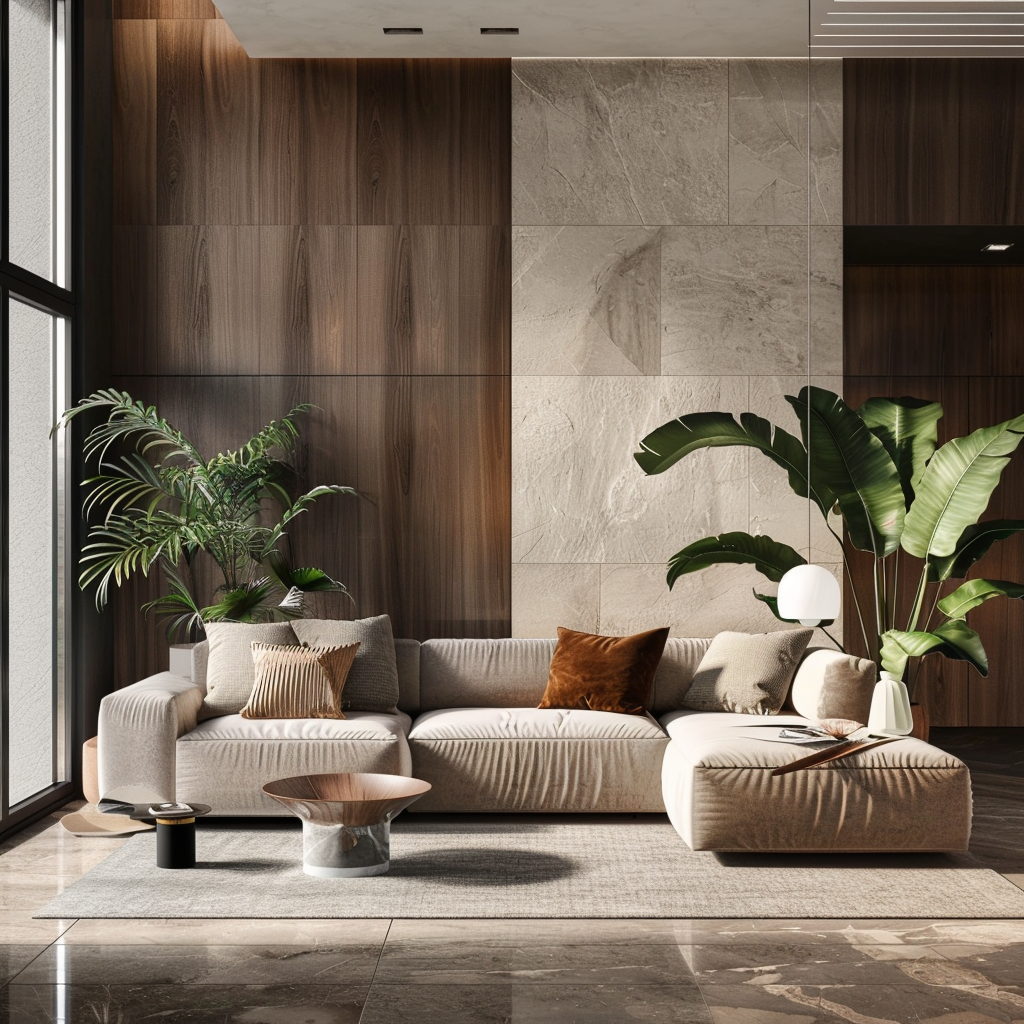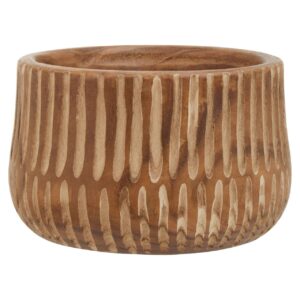Tips
A COMPREHENSIVE GUIDE TO INDOOR PLANTS FOR HOME DECOR
Unveil Luxury, Unleash Comfort – Eclectic Niche.
Indoor plants are plants that are grown indoors, typically within homes, offices, or other enclosed spaces. Over the years, indoor plants have transcended their traditional role as mere decorations to become essential elements of modern living spaces. Beyond their aesthetic appeal, indoor plants offer a myriad of benefits that contribute to our health, well-being, and overall quality of life. From purifying the air we breathe to boosting our mood and productivity, these green companions have earned a revered status in our homes, offices, and urban environments.
The practice of indoor gardening dates back centuries, with civilizations around the world incorporating plants into their living spaces for both practical and symbolic reasons. Today, indoor gardening has evolved into a thriving trend, fueled by growing awareness of the positive impacts of plants on our physical and mental health.
-

Hamilton Barnes
Banana Palm Large
£190 Add to cart -

Faux Ball Cactus Garden
£60 Add to cart -

Hamilton Barnes
Olive Tree Green
£190 – £290 Select options This product has multiple variants. The options may be chosen on the product page
Indoor Gardening Through Time
The practice of bringing plants indoors dates back thousands of years, with evidence of indoor gardens found in ancient Egyptian, Roman, and Chinese societies. In ancient Egypt, papyrus reeds were commonly grown indoors for their practical uses in making paper, baskets, and sandals. The Egyptians also cultivated date palms and fig trees inside their homes as symbols of fertility and prosperity.
During the Roman Empire, wealthy citizens adorned their villas with elaborate indoor gardens known as “viridaria.” These gardens featured a variety of plants, including fruit trees, vines, and ornamental flowers, and served as tranquil retreats for relaxation and contemplation. In China, indoor gardening became an integral part of Taoist philosophy, with scholars and monks cultivating miniature landscapes known as “penjing” or “bonsai” to evoke the beauty of nature within the confines of their living spaces.
During the Middle Ages in Europe, monasteries played a crucial role in preserving the tradition of indoor gardening, where monks cultivated medicinal herbs and aromatic plants for both culinary and therapeutic purposes.
The Victorian era saw a resurgence of interest in indoor gardening, fueled by advancements in glasshouse technology and the introduction of exotic plants from distant lands. Wealthy Victorians created lavish conservatories and orangeries to showcase their collections of tropical plants and exotic flowers, symbolizing their status and wealth.
In the 20th century, the advent of modern architecture and urbanization led to a renewed appreciation for indoor plants as a means of reconnecting with nature in an increasingly urbanized world. Today, indoor gardening has evolved into a popular hobby and lifestyle trend, with people of all ages and backgrounds embracing the beauty and benefits of cultivating plants indoors. From ancient civilizations to modern-day urban dwellers, the practice of indoor gardening continues to thrive, serving as a timeless expression of our innate connection to the natural world.
Health Benefits of Indoor Plants
The health benefits of indoor plants are numerous and have been supported by scientific research. Here are some of the key benefits:
1. Air purification: Indoor plants can help remove toxins and pollutants from the air, improving indoor air quality. Plants absorb harmful chemicals such as formaldehyde, benzene, and trichloroethylene, which are commonly found in indoor environments due to furniture, carpets, and cleaning products.
2. Stress reduction: Studies have shown that being around indoor plants can reduce stress levels and promote relaxation. The presence of greenery indoors has a calming effect on the mind and can help lower blood pressure and cortisol levels.
3. Improved mood and mental health: Indoor plants have been linked to improved mood and mental well-being. They can help reduce symptoms of depression and anxiety, increase feelings of happiness and positivity, and promote a sense of overall well-being.
4. Boosted productivity and concentration: Having indoor plants in the workplace or study environment has been shown to increase productivity and concentration. Plants help create a more pleasant and inviting atmosphere, which can enhance focus and cognitive function.
5. Better sleep: Certain indoor plants, such as lavender and jasmine, are known for their calming and sleep-inducing properties. Placing these plants in the bedroom can promote better sleep quality and help alleviate insomnia.
6. Humidity regulation: Indoor plants release moisture through a process called transpiration, which can help increase humidity levels in dry indoor environments. This can be especially beneficial during the winter months when indoor air tends to be drier.
7. Faster recovery from illness: Research has shown that patients in hospital rooms with indoor plants tend to recover more quickly from surgery or illness compared to those in rooms without plants. The presence of greenery can aid in stress reduction and promote healing.
Categories of Indoor Plants
Indoor plants can be categorized in various ways based on different criteria. These categories allows for easy selection of the right plants for specific indoor environments and personal preferences, ensuring their health and vitality in indoor spaces.
- Light requirements: Indoor plants are categorized into three based on their light requirements; low-light, moderate-light, and high-light plants. The three types vary in their ability to thrive under different levels of light intensity. Low-light plants, such as Snake plants and ZZ plants, are well-suited for environments with minimal natural light, thriving in rooms with north-facing windows or spaces that receive indirect sunlight. Moderate-light plants, like Pothos and Spider plants, require slightly more light but can still flourish in indoor areas with indirect sunlight or bright, filtered light from east- or west-facing windows. On the other hand, high-light plants, including Ficus elastica and Bird of paradise, necessitate abundant sunlight to thrive and are best placed near south-facing windows or in locations where they can receive direct sunlight for several hours each day.
- Watering needs: Indoor plants can also be classified based on their watering needs, such as low-maintenance plants that require minimal watering and high-maintenance plants that need more frequent watering and attention. Low-maintenance plants require little attention and care, making them ideal for individuals with busy schedules who may not have the time or energy to devote to intensive plant care routines. Examples of low-maintenance plants include the Snake plant, ZZ plant, and Spider plant, while high-maintenance plants include the Maidenhair fern, Boston fern, and Calathea.
- Size and growth habits: Indoor plants can be categorized based on their size and growth habits, including small, compact plants suitable for tabletops and shelves, medium-sized plants for floor or windowsill display, and large, statement plants for focal points in a room. Examples of small indoor plants include succulents, air plants, and Haworthia, while medium-sized plants include Monstera deliciosa, Fiddle leaf fig, and Chinese evergreen. Large indoor plants such as Areca palm, Dracaena marginata, and Swiss cheese plant are also popular choices for indoor greenery.
- Air-purifying properties: Indoor plants can be categorized based on their air-purifying properties, with certain plants known for their ability to remove toxins and pollutants from the air. This classification helps in selecting plants specifically for improving indoor air quality. Examples of indoor plants with air-purifying properties, filtering compounds such as formaldehyde, benzene, and xylene, include the Snake plant, Peace lily, and Spider plant.
- Edibility: Some indoor plants are grown for their edible fruits, leaves, or herbs. Herbs like Basil, Mint, and Rosemary not only provide aromatic enhancements to dishes but also thrive in indoor environments with adequate sunlight and well-drained soil. For those craving fresh fruits, Dwarf citrus trees such as Meyer lemon and Calamondin orange offer a compact yet fruitful option, producing miniature versions of their larger counterparts. Additionally, salad greens like Lettuce, Kale, and Arugula can be grown indoors, providing a continuous supply of crisp, nutrient-rich greens for salads and sandwiches throughout the year. With proper care and attention, these edible indoor plants offer a convenient and sustainable way to incorporate homegrown produce into daily culinary endeavors.
- Foliage vs. flowering: Indoor plants can be categorized based on their foliage or flowering characteristics. Examples of indoor plants valued for their lush foliage include the Snake plant, ZZ plant, and Rubber plant, while those prized for their colorful blooms include Orchids, African violet, and Anthurium.
- Climate compatibility: Indoor plants can be categorized based on their compatibility with specific indoor climates, such as plants that thrive in warm, humid conditions versus those that prefer cooler, drier environments. Examples of indoor plants suited for warm, humid conditions include orchids, ferns such as the Maidenhair fern and Boston fern, and Anthurium.
Common Types of Indoor Plants
Indoor plants come in a wide range of varieties, catering to different preferences and environments. Here are some popular types categorized based on their characteristics:
A. Low-maintenance plants for beginners
For those new to indoor gardening or looking for plants that require minimal care, low-maintenance plants are the way to go. These plants can thrive in low light conditions and tolerate occasional neglect. Some popular low-maintenance indoor plants include:
Pothos (Epipremnum aureum): Known for its trailing vines and heart-shaped leaves, pothos is one of the easiest plants to grow indoors. It can adapt to various light levels and only needs occasional watering.
Snake Plant (Sansevieria trifasciata): Also known as mother-in-law’s tongue, the snake plant is valued for its striking upright leaves and air-purifying qualities. It can survive in low light and requires minimal watering.
Spider Plant (Chlorophytum comosum): With its arching green and white striped leaves, spider plants are resilient and thrive in bright, indirect light. They are known for producing “babies” or offshoots that can be propagated into new plants.
B. Flowering plants for adding color and beauty
If you’re looking to add a pop of color and beauty to your indoor space, flowering plants are a wonderful choice. These plants produce vibrant blooms that can brighten up any room. Some popular flowering indoor plants include:
Orchids (Orchidaceae): Orchids are known for their exotic and elegant flowers. They require specific care, including proper watering and light conditions, but their stunning blooms are well worth the effort.
Peace Lily (Spathiphyllum): Peace lilies are prized for their white flowers and glossy green leaves. They are relatively easy to care for and can tolerate low light, making them perfect for indoor environments.
C. Edible plants for kitchen gardens
For those interested in growing their own food or herbs, edible plants are a fantastic option for indoor gardening. These plants not only provide fresh produce but also add flavor and aroma to your culinary creations. Some popular edible indoor plants include:
Herbs (e.g., basil, mint, rosemary): Herbs are easy to grow indoors and can be used fresh in cooking. They require well-draining soil, adequate sunlight, and regular watering to thrive.
Cherry Tomatoes (Solanum lycopersicum): While they require more space and sunlight compared to other indoor plants, cherry tomatoes can be grown successfully in containers indoors. They provide delicious, juicy tomatoes for salads, sauces, and snacks.
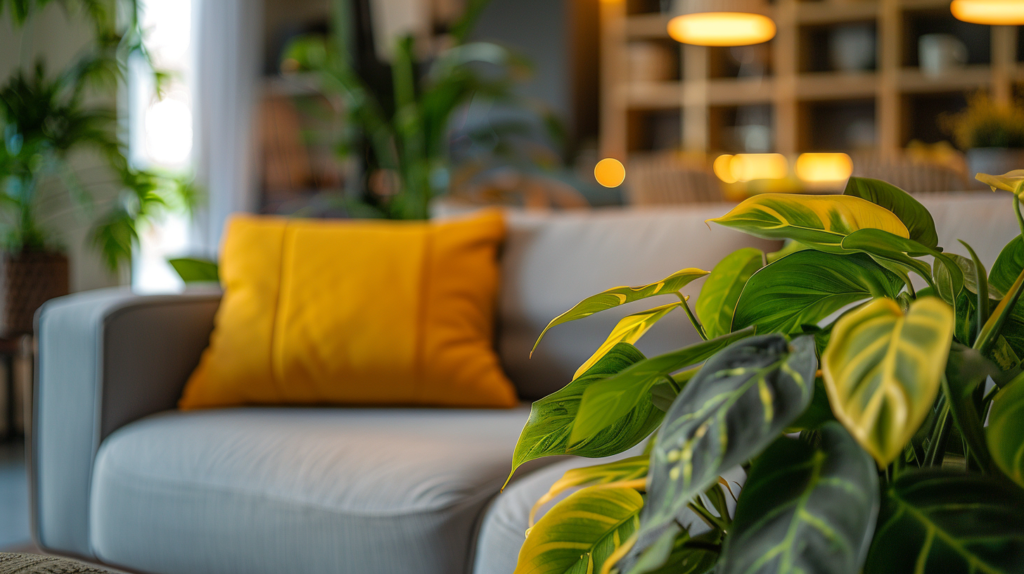

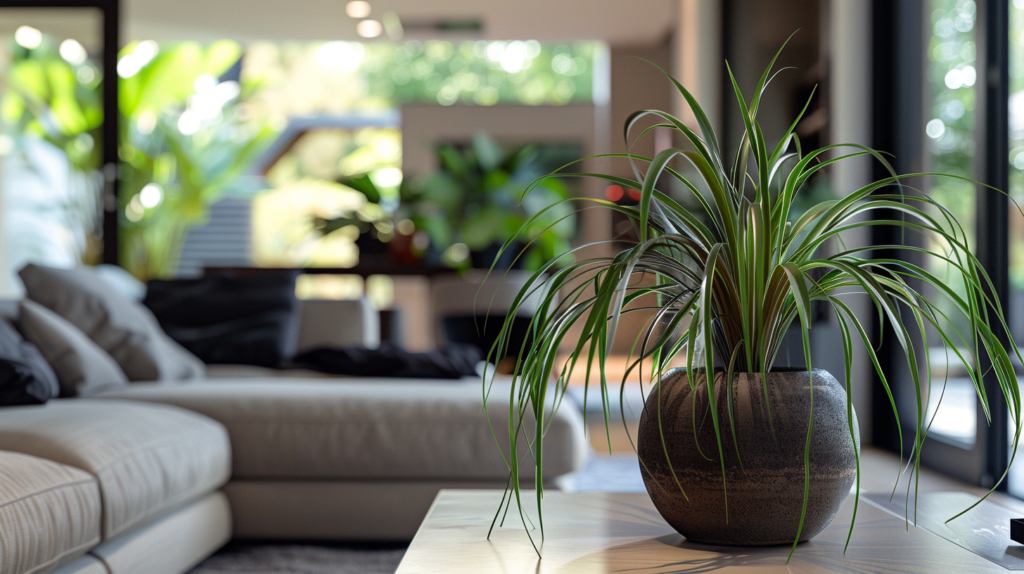

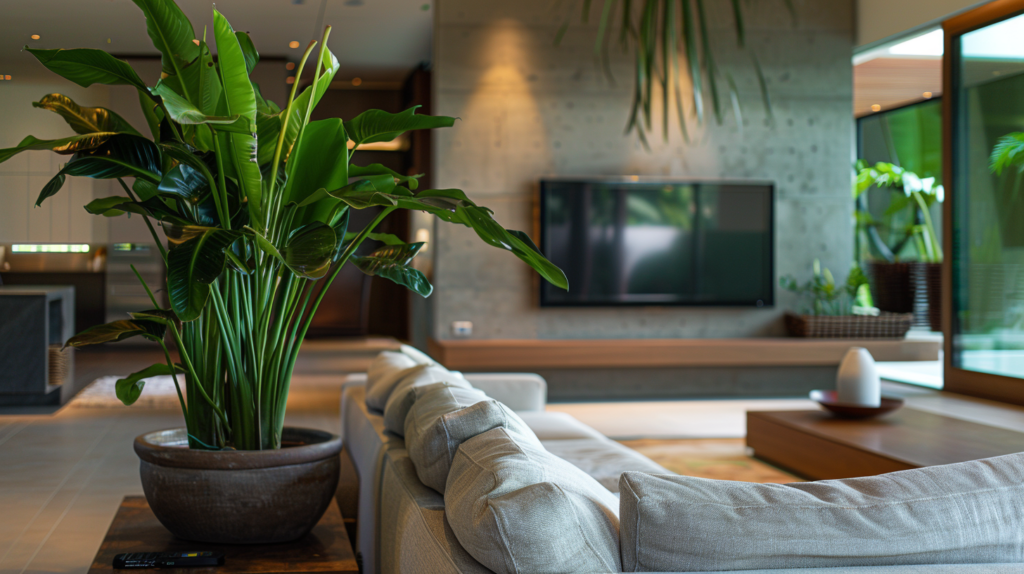
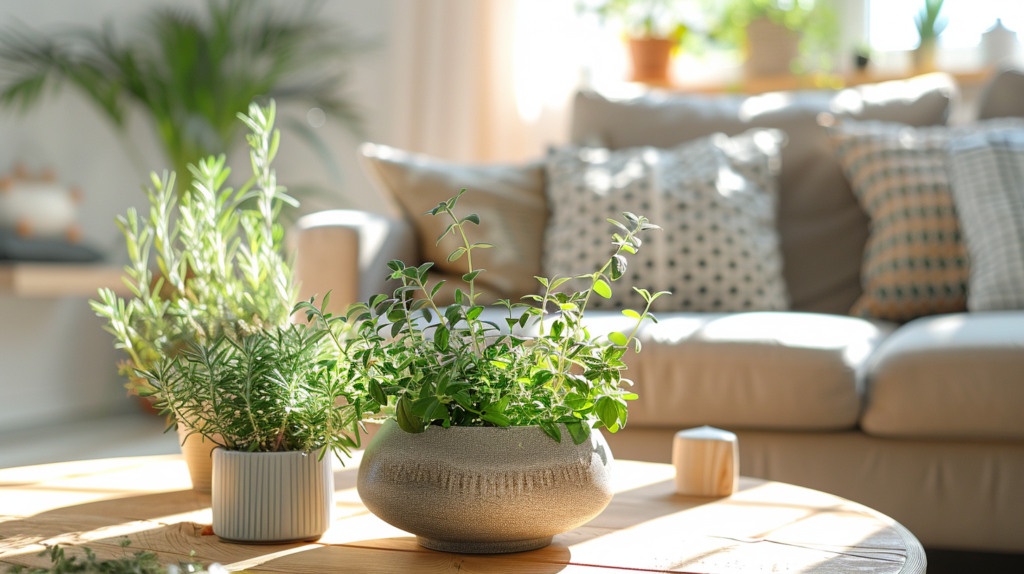
Choosing the Right Indoor Plants
Some important factors to consider when selecting indoor plants include:
1. Interior design style: Incorporating indoor plants into different interior design styles involves considering the overall aesthetic of the space and selecting plants that complement and enhance the existing décor. In minimalist interiors, where simplicity and clean lines reign supreme, choose plants with sleek, architectural shapes such as Snake plants or ZZ plants. Keep arrangements minimal, focusing on showcasing the beauty of each plant within the space. Opt for simple, understated planters that seamlessly blend with the minimalist décor, enhancing the overall sense of tranquility and harmony.
For Scandinavian interiors, characterized by light, airy spaces and natural materials, select plants that evoke a sense of warmth and coziness. Soft, rounded leaves of Pothos or Rubber plants add texture and visual interest, enhancing the natural ambiance of the room. Create inviting corners by grouping plants together in clusters, complementing the Scandinavian aesthetic with touches of greenery and organic shapes.
In bohemian interiors, where creativity and eclecticism thrive, embrace a lush, layered approach to incorporating indoor plants. Mix and match different types of plants, including trailing vines like Philodendron or Spider plants, to create a vibrant, eclectic vibe. Layer plants with colorful textiles, vintage accents, and global-inspired décor for a boho-chic look that celebrates the beauty of nature and self-expression.
In modern interiors, characterized by clean lines and contemporary design elements, use indoor plants to add drama and visual interest to the space. Statement plants like Fiddle leaf figs or Bird of paradise make bold focal points, while sleek, minimalist planters in neutral colors complement the modern aesthetic. Incorporate plants strategically to soften angular spaces and create a sense of balance between the natural and man-made elements.
For industrial interiors, where raw, unfinished materials dominate the aesthetic, juxtapose industrial elements with lush, green plants to add warmth and texture to the space. Select plants like Monstera deliciosa or Snake plants that contrast with the ruggedness of exposed brick and concrete. Opt for industrial-style planters in metal or concrete finishes, seamlessly integrating plants into the urban landscape while enhancing the overall industrial chic vibe.
In traditional interiors, characterized by elegance and timeless charm, choose classic houseplants like Peace lilies or Boston ferns to complement the traditional décor. Select decorative planters in classic patterns or finishes, such as porcelain or brass, to enhance the traditional aesthetic. Incorporate plants strategically to add a touch of freshness and vitality to the space, while maintaining the timeless elegance of the traditional interior design style.
2. Plant Characteristics: Understanding plant properties is crucial as they directly influence how well a plant will thrive in a particular indoor environment and how much care it will require. Factors such as light requirements, watering needs, size and growth habit, air purifying properties, aesthetic preferences, climate compatibility, and maintenance requirements all play a significant role in determining the suitability of a plant for a given space. For instance, different plants have varying maintenance requirements, including pruning, repotting, and pest control. Selecting plants that match your level of gardening expertise and commitment to maintenance helps ensure their long-term health and success. Also, choosing a plant that fits its designated location helps prevent overcrowding and the need for frequent pruning or repotting.
Selecting plants that match the available light conditions, watering habits, space constraints, and aesthetic preferences helps ensure that they thrive and enhance the indoor environment while minimizing the need for intensive care and maintenance.
3. Pet and Child Safety: Pet and child safety is a crucial factor in choosing indoor plants because some plants can be toxic if ingested, leading to potentially harmful or even fatal consequences. Pets, such as dogs and cats, and young children are curious by nature and may be tempted to explore and nibble on indoor plants, especially if they are within reach. Ingesting certain plants can cause symptoms ranging from mild gastrointestinal upset to more severe reactions, including vomiting, diarrhea, difficulty breathing, and even organ failure. Therefore, it’s essential to be aware of the toxicity levels of indoor plants and choose non-toxic varieties to ensure the safety of pets and children in the household. Before purchasing a plant, research its toxicity level and potential health effects on pets and children. Many resources, including plant databases and pet safety websites, provide information on toxic and non-toxic plants. Some toxic plants include lilies, philodendrons, dieffenbachias, and certain types of ferns and ivies. Avoid these plants or place them out of reach of pets and children.
Selecting Indoor Plants for Spaces
Choosing the right indoor plants for different spaces in your home involves considering several factors to ensure their health and aesthetics blend well with the environment. Here’s an in-depth look at how to select indoor plants based on light conditions, specific rooms, and plant size/growth habits:
Considerations for Choosing Plants Based on Light Conditions
1. Low Light Conditions: Areas with low natural light, such as hallways or rooms with small windows, require plants that can thrive in such conditions. Opt for plants like:
- Snake Plant: Known for its resilience in low light and air-purifying qualities.
- ZZ Plant: Requires minimal light and is drought-tolerant, making it ideal for low-light areas.
- Peace Lily: Thrives in low to medium light and produces elegant white flowers.
2.Bright Light Conditions: Spaces with ample sunlight, such as south-facing windows or sunrooms, are suitable for plants that love bright light. Consider:
- Succulents and Cacti: These desert plants thrive in bright, direct sunlight and require infrequent watering.
- Orchids (Orchidaceae): Known for their stunning blooms, orchids prefer bright, indirect light for optimal growth.
- Bromeliads: Tropical plants that enjoy bright light and can add a splash of color to your space.
3. Indirect Light Conditions: Rooms with filtered or indirect sunlight, such as east or west-facing windows, offer versatility for a wide range of plants. Examples include:
- Pothos: Versatile and easy to care for, pothos can thrive in various light conditions.
- Ferns: Many fern varieties, such as Boston ferns or maidenhair ferns, prefer indirect light and high humidity.
- Spider Plant: Adaptable to different light levels, spider plants are great for indirect light areas.
Matching Plants to Specific Rooms
1. Living Room: Consider plants that complement your living room decor and create a welcoming atmosphere:
- Fiddle Leaf Fig : A popular choice for its large, glossy leaves and dramatic presence.
- Rubber Plant : Known for its sturdy, dark green leaves and tolerance to various light conditions.
- Hanging Plants: Add dimension with hanging plants like a string of pearls, pothos, or trailing philodendrons.
2. Bedroom: Opt for plants that promote relaxation and improve air quality for better sleep:
- Snake Plant: Releases oxygen at night and is known for its air-purifying properties.
- Lavender : Not only aromatic but also promotes relaxation and stress relief.
- Aloe Vera: Doubles as a medicinal plant and requires minimal care, making it ideal for bedrooms.
3. Kitchen: Choose herbs and edible plants that thrive in well-lit areas and can be harvested for culinary use:
- Basil, Mint, and Rosemary are herbs that flourish in bright light and add flavor to your cooking.
- Cherry Tomatoes: Compact fruiting plants suitable for containers and provide fresh tomatoes for salads or snacks.
- Compact Citrus Trees: Dwarf citrus varieties like Meyer lemon or calamondin can thrive indoors with sufficient sunlight.
4. Bathroom: Select plants that can withstand high humidity and low light levels typical of bathrooms:
- Ferns: Boston ferns or bird’s nest ferns thrive in humid environments and can tolerate low light.
- Pothos: Hardy and adaptable, pothos can thrive in bathrooms with adequate indirect light.
- Bamboo: Adds a touch of elegance and thrives in high-humidity areas like bathrooms.
Using Plant Size and Growth Habits to Determine Plant Placement
Hanging Plants: Utilize hanging baskets or macrame plant hangers for trailing or cascading plants like pothos, philodendrons, and string of pearls. Hang them near windows or in well-lit areas to showcase their foliage.
Tabletop Plants: Small to medium-sized plants like succulents, cacti, and small ferns are perfect for tabletops, shelves, or plant stands. Choose decorative pots or containers that complement your decor.
Floor Plants: Large floor plants, such as fiddle leaf figs, monstera deliciosa, and palms, can serve as focal points in spacious rooms. Place them in corners or near windows where they can receive adequate light and space to grow.
Styling Ideas for Indoor Plants
Elevate your indoor space with plants and explore creative styling ideas to enhance their beauty:
A. Incorporating Plants into Home Decor
Choose Stylish Planters: Elevate your plant display by selecting planters or pots that align with your interior decor style. Consider options such as:
- Ceramic Pots: Add a touch of elegance with glazed ceramic pots in vibrant colors or subtle tones.
- Woven Baskets: Create a bohemian-chic look with woven baskets that offer a natural and textured aesthetic.
- Minimalist Containers: Opt for sleek and minimalist containers like matte-finish pots or geometric planters for a modern vibe.
Consider Plant Stands: Add dimension to your plant display by incorporating plant stands or shelves. Explore these ideas:
- Tiered Plant Stands: Showcase multiple plants at varying heights for a dynamic and visually appealing arrangement.
- Floating Shelves: Create a floating garden effect by arranging small plants on wall-mounted shelves, adding depth to your decor.
- Macrame Hangers: Infuse a touch of vintage charm with macrame plant hangers, ideal for hanging trailing plants or air plants.
B. Creating Indoor Plant Arrangements and Groupings
Group Plants by Similar Needs: Simplify plant care by grouping plants with similar light and water requirements together. Consider these grouping strategies:
- Low-Light Grouping: Combine low-light plants like snake plants, ZZ plants, and peace lilies for a cohesive display in dimly lit areas.
- Succulent Collection: Create a desert-themed arrangement with a variety of succulents, arranging them in a shallow dish or succulent garden planter.
- Herb Garden: Group culinary herbs like basil, mint, and thyme in a kitchen herb garden for both functionality and aesthetics.
Create Focal Points: Make a statement with larger plants as focal points to anchor your indoor spaces:
- Statement Floor Plant: Place a tall fiddle leaf fig or monstera deliciosa in a prominent corner to add drama and greenery to the room.
- Hanging Centerpiece: Hang a cascading plant like a string of pearls or pothos from the ceiling to create a striking focal point above a dining table or seating area.
- Tabletop Oasis: Arrange a cluster of small potted plants on a coffee table or sideboard, creating a lush and inviting centerpiece.
C. Using Plants to Enhance Specific Design Themes
Tropical Vibes: Embrace a tropical paradise indoors by incorporating lush and leafy plants that evoke a sense of the tropics:
- Palm Paradise: Introduce palm plants like Areca palms or Kentia palms to infuse a tropical oasis ambiance into your living space.
- Monstera Madness: Display monstera plants with their iconic split leaves to bring a touch of jungle sophistication to your decor.
- Bromeliad Beauty: Add pops of color with bromeliads, known for their vibrant blooms and tropical allure.
Minimalist Aesthetics: Achieve a clean and streamlined look with minimalist plant styling:
- Sleek Succulents: Showcase a collection of succulents in minimalist containers like concrete pots or glass terrariums for a contemporary touch.
- Air Plant Art: Create minimalist plant art by arranging air plants (Tillandsia) on wire grids or geometric sculptures, enhancing modern decor with living art.
- Vertical Greenery: Install vertical planters or green walls using minimalist planters to maximize space and create a living wall feature.
Bohemian Flair: Infuse a bohemian vibe into your space with eclectic plant arrangements and decorative elements:
- Macrame Magic: Hang trailing plants like spider plants or philodendrons in macrame hangers, adding a whimsical and artistic touch to your decor.
- Vintage Pottery: Display plants in vintage pottery or terracotta planters to create a rustic and eclectic feel, perfect for boho-inspired interiors.
- Mixed Textures: Combine plants with varying textures, such as fuzzy-leafed plants like African violets or begonias with smooth-leaved varieties, for a visually rich and textured display.
Creating Indoor Plant Displays
Indoor plant displays are arrangements or groupings of indoor plants designed to enhance the aesthetic appeal of indoor spaces. They can range from simple arrangements of potted plants on tabletops or shelves to more elaborate displays such as vertical gardens, terrariums, and hanging planters. Here are some popular indoor plant displays and how they can be created:
1. Vertical Gardens: Vertical gardens, also known as living walls or green walls, are vertical displays of plants attached to a wall or freestanding structure. They can be created using a variety of methods, including mounting plants on a trellis or wire grid, using modular planters, or installing specialized vertical garden systems. Vertical gardens can transform bare walls into vibrant living artworks and are ideal for maximizing space in small indoor environments.
2. Terrariums: Terrariums are miniature ecosystems enclosed in glass containers, typically featuring a variety of small plants, mosses, and decorative elements. To create a terrarium, start with a clean, clear glass container and layer it with gravel or pebbles for drainage, followed by activated charcoal to prevent odors and mold. Add potting soil and arrange a selection of small indoor plants, such as succulents, ferns, or air plants, in the container. Finish with decorative elements like rocks, driftwood, or figurines to create visual interest.
3. Hanging Planters: Hanging planters are suspended containers that hold trailing or cascading plants, adding vertical interest to indoor spaces. To create a hanging planter, choose a sturdy container with drainage holes and attach it to a hook or ceiling-mounted bracket using strong rope, chains, or macramé hangers. Select trailing plants such as pothos, spider plants, or string of pearls, and plant them in the container, ensuring proper drainage and room for growth. Hang the planter in a well-lit area where it can receive adequate sunlight or artificial light.
4. Indoor Plant Arrangements: Indoor plant arrangements involve grouping different types of plants together in a visually appealing manner. To create an indoor plant arrangement, consider factors such as plant size, color, texture, and growth habit. Choose a variety of plants with complementary features and arrange them in a decorative container or planter, incorporating elements like rocks, pebbles, or moss to add interest. Place the arrangement in a prominent location where it can be appreciated, such as a coffee table, sideboard, or entryway.
Maintenance for Indoor Plants
Maintaining indoor plants involves regular care and attention to ensure their health and vitality. Here are some maintenance and troubleshooting tips for indoor plants:
1. Watering: Water indoor plants when the top inch of soil feels dry to the touch, adjusting frequency based on the plant’s specific watering needs and environmental conditions. Avoid over-watering, which can lead to root rot, and under-watering, which can cause dehydration and wilting.
2. Light: Place indoor plants in locations with appropriate light levels according to their specific light requirements. Monitor for signs of insufficient light (e.g., leggy growth, pale leaves) or too much light (e.g., scorched or bleached leaves) and adjust placement accordingly.
3. Pruning and Grooming: Regularly prune dead or yellowing leaves, spent flowers, and leggy growth to promote healthy growth and maintain the plant’s appearance. Groom plants by removing dust and debris from leaves with a soft, damp cloth to improve air circulation and photosynthesis.
4. Fertilizing: Feed indoor plants with a balanced liquid fertilizer according to label instructions during the growing season (spring and summer). Avoid over-fertilizing, which can cause nutrient imbalances and burn the plant’s roots.
5. Pest Control: Monitor indoor plants for signs of pests such as aphids, mealybugs, spider mites, and scale insects. Treat infestations promptly using insecticidal soap, neem oil, or other organic pest control methods to prevent damage to the plant.
6. Disease Management: Watch for symptoms of common plant diseases such as powdery mildew, root rot, and fungal infections. Improve air circulation, avoid over-watering, and remove affected plant parts to prevent the spread of disease.
7. Repotting: Repot indoor plants into larger containers with fresh potting soil as needed to provide room for growth and replenish nutrients. Repotting is typically done every 1-2 years or when the plant outgrows its current container.
8. Temperature and Humidity: Maintain consistent temperature and humidity levels suitable for indoor plants, avoiding extremes such as drafts, hot air vents, or dry indoor air. Grouping plants together can help create a microclimate with higher humidity levels.
9. Seasonal Care: Adjust care routines seasonally to accommodate changes in light levels, temperature, and humidity. Reduce watering and fertilizing during the winter months when plant growth slows, and increase ventilation to prevent humidity-related issues.
10. Observation: Regularly inspect indoor plants for signs of stress, damage, or changes in growth. Pay attention to leaves, stems, and soil conditions, and address any issues promptly to prevent further problems.

